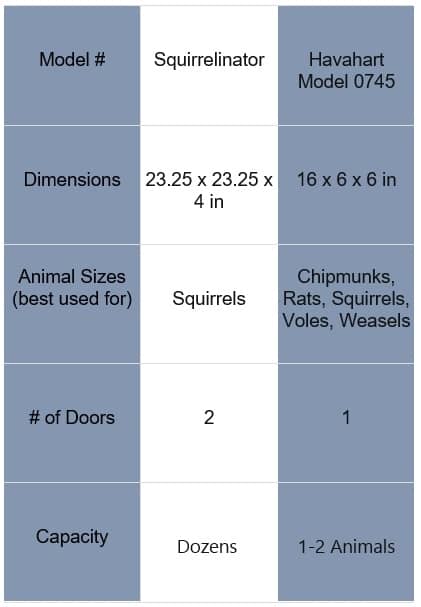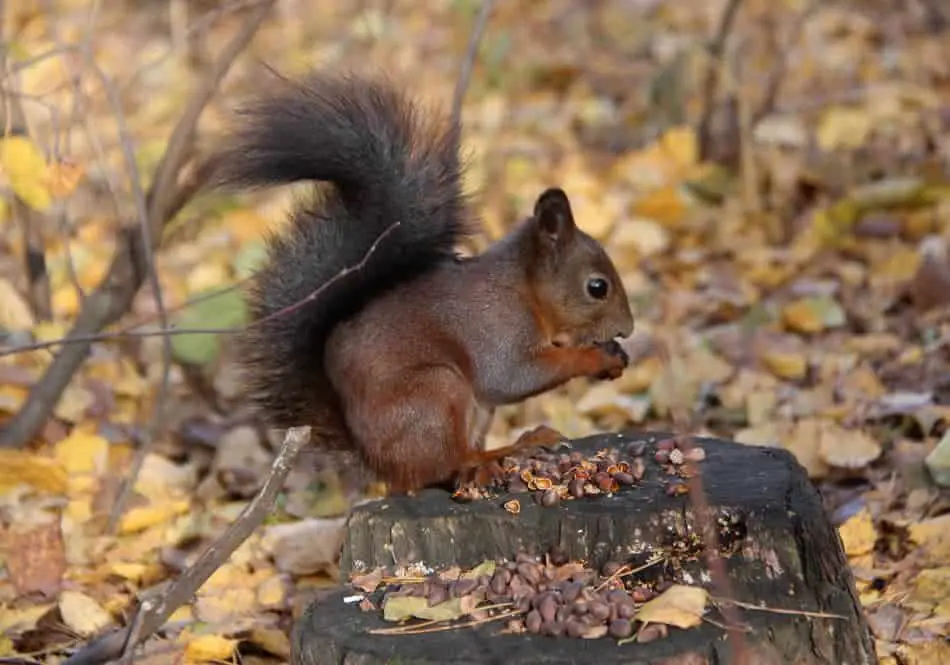Are you looking for the best products available to humanely catch common small to medium-sized mammals or “pests” without causing harm to the animals? Then, you’ve come to the right place!
The two products reviewed here are, without a doubt, the best humane traps on the market for catching small to medium-sized mammals. They’re both very effective, so you can’t really lose. But, they do vary in specific ways, so we’ll be covering the relative advantages and disadvantages of both.For those of you who are in a rush, the two models recommended in this article are the Havahart Model 0745 and the Rugged Ranch Squirrelinator.
After nearly two years of living with squirrels in the attic, and trying various methods to get them to move on (deterrents and aromatic substances, etc.), I eventually found the best way to deal with the issue is to employ humane catch and release practices.
After trying several products (generic stuff from Target, etc.), I found the above two products to be the most reliable and effective.
Quick Comparison Chart

Rugged Ranch Squirrelinator
First up, is the Squirrelinator. We’ll go over the key features here as well as some of the disadvantages.
Main Advantage: Multi-Catch Capacity
The main advantage of the Squirrelinator is that it has the capacity to catch dozens of squirrels in a matter of hours.
Contrast that with weeks on end that it takes to get squirrels to leave a given space using all natural aromatic substances that supposedly deters the with odor. If such measures work at all. I never noticed a difference.
Anyway, you can be sure that with the right bait, you can easily get the job done in a day or two. At least, that’s been my experience.
Larger Size
The large capacity (23.25 x 23.25 x 4 in) allows for catching several squirrels at once. Given that most people use these devices outdoors or up in attics, the larger size tends not to be an issue as far as space is concerned.
Having a larger size trap is also convenient because you don’t have to purchase multiple smaller traps. So, with this device, you can focus on catching squirrels in one setting.
Multiple Doors
The unit comes with two doorways, where squirrels enter and have the freedom to move to the center, allowing more animals to enter.
Having more trap doors is beneficial because it allows the animals to enter from more than one direction.
Main Disadvantage: Limited to Squirrels
What the Squirrelinator does, it does well. Unfortunately, the wire hole size is too big for chipmunks and other small mammals like rats.
If you’re primarily concerned with squirrels, this product is the way to go. But, if there are other animals you’d like to catch, you may want to go with another product.
Warning: Don’t Purchase the Basin
As a cruelty-free animal control DIYer, you’ll definitely want to avoid purchasing the basin. Not all models come with it, but it does cost extra and you’ll have no use for it, so it will be money wasted.
I’m not exactly sure what the basin is for, but it seems that folks who use it, tend to use it for drowning the animal. This article is written for people who want to use catch and release methods of animal control. Not catch and kill.
Havahart Live Animal Cage Trap Model 0745
This model of the Havahart is designed for catching small to medium-sized mammals. It’s one of the only Havahart models that’s advertised to catch squirrels and chipmunks.
Main Advantage: Catches a Wide Range of Smaller Animals
Unlike other Havahart Models, it doesn’t catch larger animals like armadillos, groundhogs, opossums, skunks, raccoons, or muskrats. Instead, the Havahart 0745 One-Door Animal Trap is designed for squirrels, chipmunk, rats, and weasels.
This device uses a trip-plate sensitive enough to capture tiny animals (even mice) and is designed with a close-set 12-gauge wire mesh that is able to contain them. Upon setting off the trigger, the gravity-action door closes behind them, safely holding the animal until you can release it.
In any case, it has the capacity to catch quite a wide variety of smaller animals compared to the Squirrelinator.
Main Disadvantage: Limited to Catching 1-3 Animals at a Time
At 16 x 6 x 6, the dimensions are less than half of that of the Squirrelinator. So, while it catches several different types of animals, it would take quite some time to deal with larger infestations.
I used the Squirrelinator to remove about 10 squirrels from my attic at once. Using this device, I only ever managed to catch one or two at a time. Which is not a problem if you’re dealing with a small number of animals.
The Down Side of Catch And Release
When using the catch and release method of animal control, you want to exercise caution when relocating the animals.
Many well-meaning animal lovers, transport trapped animals to unsuitable surroundings. What looks inviting to humans, can be quite uninviting to the animals they’re releasing.
It turns out wild animals don’t “settle in” very quickly to new surroundings. In fact, the odds of survival are pretty low when the animal is taken from the suburbs and put into the woods or a strange park.
A 2004 study cited by the Humane Society found that when a population of grey squirrels were live-trapped in suburban areas and relocated to a large forest, 97% of the squirrels soon died or disappeared from the area in which they were released (see reference at the end of the article).
Difficulties faced by newly relocated animals include:
- Disorientation. When you’re unfamiliar with an area, it makes it more difficult to find food, water, and shelter compared to areas that have been previously mapped out by the species.
- Hostility/teritorriality. They now find themselves in another animal’s territory where they’re often chased out or attacked.
- Diminished ability to escape predation. They’re unfamiliar with escape routes needed to avoid predators.
- Orphaning of young. They’re now separated from family, which orphans the young. Squirrels are very social critters, and younger squirrels rely on the mother for food and protection.
In the previous article on humane “pest” control, we covered the ethics surrounding animal control in the vegan community. If you read the article, you know that some vegans use lethal methods when it comes to dealing with unwanted animals.
If some vegans resort to lethal measures, it should follow that relocation is definitely an option as a vegan, even if it potentially leads to undesirable outcomes.
When it comes to removing squirrels from inside your property (such as the attic), then this is much less of an issue.
Trapping them once and releasing them outside of your house (in your backyard, etc.) is usually enough—at least, in my experience—to scare them sufficiently such that they don’t return for the rest of the winter (squirrels tend to inhabit attics when the weather gets cold).
When dealing with animals outside of your home, such as in your garden, the situation gets more complicated. I’ve never had to deal with animals outside of my residence—such as in a garden, etc. so I can’t speak from experience.
You could try relocating the animals to a nearby place—even within walking distance—that has the same climate, food sources, etc.
Ultimately, it’s your decision. And relocating animals to a different area altogether would not make one inhumane or non-vegan.
Conclusion
That wraps up the comparison. Thanks for reading.
You can find the current price for the Rugged Ranch Squirrelinator here.
Humane Society reference: Scrap the Trap When Evicting Wildlife. https://www.humanesociety.org/resources/scrap-trap-when-evicting-wildlife

